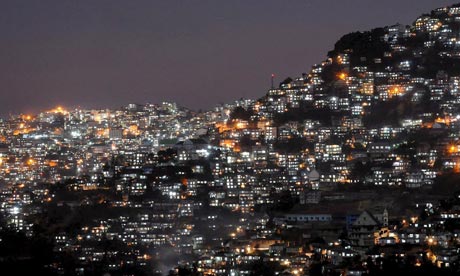Long sheltered by its remote location, the capital of Mizoram state must learn to manage the maelstrom of modern India
By Paul Grogan

Aizawl, capital of Mizoram state, at dusk. Photograph: STR/EPA
I am sitting on a balcony looking out on one of the more extraordinary places on earth.
Teenage girls and boys "hang out" beside the headstones in the graveyard below me. Pigs squeal and grunt in their little pens amid the banana trees and corrugated iron houses.
I am in Aizawl, capital of Mizoram state, which extends like a peninsula into one of the farthest corners of northeast India. Burma lies about 50km to the east, and Bangladesh is nearly as close on the western side. Steep bamboo-forested hills descend deep below me on almost all sides.
Aizawl's houses are built on stilts that cling to the hillsides – even the mildest earthquake would surely destroy this place in minutes. The city sprawls across several ridge tops that are connected by steep narrow roads and hundreds of hairpin bends.
Driving for the uninitiated is definitely not recommended. In fact, the state banned alcohol in 1995 apparently because there were so many road accidents involving inebriated young drivers.
Right now, Aizawl seems to be undergoing extraordinary tensions and changes. The Mizo people are of Chinese/Mongolian origin, and were converted by Presbyterian missionaries at the beginning of the last century. They live simply, using the slash-and-burn form of agriculture that has been outmoded in most of the rest of the world.
These million or so people live at least 30 hours by road from mainland India. Their distinct ethnicity, culture, religion and location might make them easily forgotten within the intense maelstrom of Indian politics.
But while the Mizos are a friendly and relatively peace-loving people, the state's international borders may provide an easy conduit for the movement of arms, fighters and drugs into other parts of India.
Over the past decade, Delhi has poured billions of rupees into Mizoram, and Aizawl now has an airport and a new university. But how can a city with such an extraordinary geography support these developments over the long term? There isn't enough space, the slopes are too severe to widen the roads much, the agricultural base is weak, and an industrial base is almost unimaginable.
The teenagers in the graveyard below have now disappeared – no doubt gone indoors to watch CNN or Bollywood or some such. May they be pacified.
via Guardian Weekly







0 comments:
Post a Comment